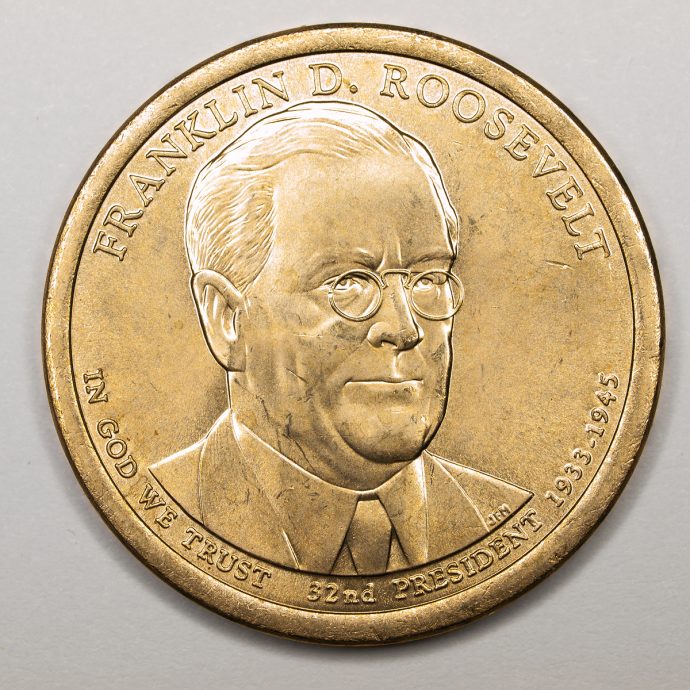Abandoning Gold and the Constitution?
Constitutional law scholars tend to focus on decisions involving abortion, same-sex marriage, desegregation, and administrative law, ignoring one of the 20th century’s most contentious legal battles: creditors’ challenge to President Franklin D. Roosevelt’s abrogation of the gold standard, and contemporaneous invalidation of “gold clauses” in contractual debt obligations, in 1933. The New Deal spawned many events of interest to constitutional historians—such as FDR’s court-packing scheme, the abandonment of the Lochner line of cases, and the Carolene Products decision—but until the publication of Sebastian Edwards’s American Default in 2018, the great debt default of 1933-1935 had unaccountably been largely overlooked. [1] In the pre-“woke” era, constitutional battles were over economics, not culture, and no aspect of the economy is more fundamental than money.
In response to the Great Depression, one of Roosevelt’s first acts as President, after taking office in March 1933, [2] was to ban the private ownership of gold—in the form of coins, bullion, or gold certificates—and to require all private gold holdings to be sold to the federal government at a set price. This unprecedented edict was quickly followed by taking the nation off the gold standard. Then, on June 5, 1933, at FDR’s behest Congress passed Joint Resolution No. 10, unilaterally annulling all “gold clauses”—contractual provisions requiring repayment of debts in gold, used in most bonds and mortgages since the Civil War to protect lenders against devaluation of paper money—in all past and future debt contracts, public and private. As the coup de grace, in January 1934, FDR devalued the currency by fixing a new price for gold almost 70 percent higher than its century-old price.
Thus, to aid distressed farmers, debtors were allowed to repay their obligations with watered-down dollars, despite gold-denominated repayment obligations. Beleaguered rural voters favored inflation. (To remedy crippling deflation, FDR’s overarching goal was to increase domestic prices, especially for farm products.) Through these combined actions, the President and Congress had effectively wiped out more than 40 percent of all existing debt. Creditors were livid. Bond holders who had purchased securities protected by gold clauses challenged the annulment as unconstitutional. This became one of the first skirmishes over the New Deal to be decided by the Supreme Court. In early 1935, following three days of argument, in a trio of related decisions [3] the Court upheld the federal government’s actions in a series of 5-4 decisions written by Chief Justice Charles Evan Hughes, with the conservative “Four Horsemen” dissenting.
The majority blithely upheld the Joint Resolution invalidating gold clauses in private contracts, citing broad congressional power to regulate the economy and, with respect to the impairment of government obligations, denying that bond holders had been damaged by the taking. The rationale of Hughes’s opinion in the public debt cases was that annulment of the gold clause caused no economic injury to the bondholders because—even had the debt been repaid in gold coin—other features of FDR’s monetary reforms would have required that the gold be surrendered at a fixed price (less than actual market value). [4] The dissenters, who viewed FDR’s scheme as an abhorrent and dishonorable repudiation of contractual obligations, scoffed at this reasoning: “Obligations cannot be legally avoided by prohibiting the creditor from receiving the thing promised.” Justice James Clark McReynolds delivered the unitary dissent, departing from the prepared opinion to scornfully declare that the Constitution “is gone,” bitterly lamenting that “Shame and humiliation are upon us now.”
This long-forgotten showdown occurred two years before the fateful “switch in time that saved nine,” but after the evisceration of the Contract Clause in Home Building & Loan Association v. Blaisdell (in another 5-4 opinion, also penned by Hughes). [5] To some extent, the result in the closely-watched Gold Clause Cases was pre-ordained: many financial analysts had publicly predicted that a ruling against the FDR administration would plunge the country into a catastrophic crisis. According to Edwards, it was “plainly clear” that invalidating the Joint Resolution “would create chaos, including millions of bankruptcies across the country.”
American Default tells a fascinating story. Edwards, who teaches international economics at UCLA, brings a sophisticated knowledge of finance to his analysis of the chaotic conditions underlying the Great Depression, the circumstances leading up to FDR’s decision to nullify the gold clauses, and the international implications of this action. (The author casually name-drops prominent economists with whom he has rubbed elbows over the years, including Milton Friedman, Anna Schwartz, and Allan Meltzer.) His account goes behind the scenes in 1933, which he suggests is “possibly the most eventful year in American history during times of peace.” The full cast of characters who played a role in the vaunted “First 100 Days” are often over-shadowed by FDR himself. Edwards explores the personalities of Roosevelt’s New Deal advisers, especially the economists and so-called Brains Trust.
Edwards suggests that FDR’s team was ill-equipped to manage the intricacies of monetary policy. Much of what the would-be central planners did was a haphazard experiment. Indeed, FDR did not choose his Secretary of the Treasury until shortly before he was sworn in as President. Most of FDR’s agenda during the “Hundred Days” has been panned by economists and historians. The Agricultural Adjustment Act and National Industrial Recovery Act, both struck down as unconstitutional, accomplished little. The Great Depression continued throughout the decade of the 1930s. Nevertheless, Edwards maintains that FDR’s tempestuous monetary reforms in 1933-34 arrested the nation’s economic freefall and boosted prices. Moreover, Edwards concludes—albeit with qualifying caveats—that the debt default engineered by FDR had no apparent deleterious effect on America’s economy in the long run. In both cases, Edwards offers charts and technical data (complete with “M1”) in support of his position. Friedman and Schwartz reached the opposite conclusion in their 1963 book A Monetary History of the United States, 1867-1960.
How well does the book, subtitled The Untold Story of FDR, the Supreme Court, and the Battle Over Gold, hold up as legal history or constitutional analysis? We have become inured to fiat currency and monetary gimmicks on the part of the Federal Reserve, but are these innovations consistent with an originalist understanding of the Constitution? What did the Framers mean when granting to Congress the power to “coin money [and] regulate the value thereof”? [6] Were FDR’s reforms within the purview of the Constitution’s “necessary and proper” clause? [7] Were the Reconstruction-era Legal Tender Cases [8] correctly decided? These questions deserve comprehensive treatment. That argument isn’t contained in Edwards’ book. In contrast to Edwards’ economic analysis, his legal narrative is somewhat superficial, derived in large part from contemporaneous accounts, some historical archives, and William Leuchtenberg’s 1995 book The FDR Years: On Roosevelt and His Legacy, which he describes as “the standard work on the Supreme Court during the time of Roosevelt.”
Edwards acknowledges that the statutory authority for declaring a national bank holiday was “doubtful,” and notes that acting Treasury Secretary Dean Acheson resigned his post because of his concerns that the administration’s policies were illegal. Beyond this, his largely journalistic rendition of the Supreme Court litigation is informative and may satisfy a general audience, but does not break new ground as legal scholarship. In fairness, this was not the author’s intent; yet, an account of the Gold Clause Cases is incomplete without a reckoning of the larger constitutional questions. [9]
Although FDR’s abandonment of the gold standard is a bell that even Robert Bork conceded was impossible to un-ring, the efficacy of economic policy does not necessarily determine its constitutionality.
[1] A prominent exception is Kenneth Dam’s article, “From the Gold Clause Cases to the Gold Commission: A Half Century of American Monetary Law,” 50 U. of Chicago Law Review 504 (1983).
[2] Presidential inaugurations were moved to January following adoption of the 20th Amendment.
[3] Norman v. Baltimore & Ohio Railroad Co., 294 U.S. 240 (1935) (consolidated with United States v. Bankers Trust Co.); Nortz v. United States, 294 U.S. 317 (1935); and Perry v. United States, 294 U.S. 330 (1935).
[4] Harvard Law School professor Henry Hart opined that “[f]ew more baffling pronouncements, it is fair to say, have ever issued from the United States Supreme Court.”
[5] 290 U.S. 398 (1934).
[6] Article I, section 8.
[7] Id.
[8] Knox v. Lee and Parker v. Davis, 79 U.S. 457 (1871) (overruling Hepburn v. Griswold, 75 U.S. 603 (1870)). See Robert G. Natelson, “Paper Money and the Original Understanding of the Coinage Clause,” 31 Harvard Journal of Law & Public Policy 1017 (2008).
[9] Gerard N. Magliocca, “The Gold Clause Cases and Constitutional Necessity,” 64 Florida Law Review 1243 (2012).

